
Features And Capabilities
JavaTerminal (or Java Terminal) is a
simple TELNET Bulletin Board System client written in Java which
focuses on rendering rather than a full TELNET or ANSI X3.64
implementation. The two available protocols are TELNETBBS and
ANSIBBS which are both subsets of the their respective protocol
specifications. The goal of the project is to make available a
simple and good looking client implemented entirely in Java. If
you are
interested in seeing new features added or participating in the
project, please follow the SourceFORGE Project link at the top of the
document.
Installation And Requirements
This software has been tested with Sun
Java 1.4 and above on the Windows and GNU Linux operating systems.
Because the program uses advanced Java
Collections Framework classes there is no plan to make it compatible
with previous versions of Java.
Installation of JavaTerminal is trivial. Most operating systems associate the JAR extension such that double clicking on the distributed JAR file will execute the application. However if your system does not know what to do with an executable JAR, please follow the these instructions.
drive:\path\to\jre\bin\JAVAW -JAR drive:\path\to\javaterminal\JT-version.JAR
OR
drive:\path\to\jre\bin\JAVA -JAR drive:\path\to\javaterminal\JT-version.JAR
/path/to/jre/bin/java -jar /path/to/javaterminal/JT-version.JAR
Installation of JavaTerminal is trivial. Most operating systems associate the JAR extension such that double clicking on the distributed JAR file will execute the application. However if your system does not know what to do with an executable JAR, please follow the these instructions.
Windows operating system users
Type the following in the RUN dialog found in the Start menu or at the COMMAND/CMD prompt.drive:\path\to\jre\bin\JAVAW -JAR drive:\path\to\javaterminal\JT-version.JAR
OR
drive:\path\to\jre\bin\JAVA -JAR drive:\path\to\javaterminal\JT-version.JAR
*nix variants (such as Linux or BSDs)
Type the following in a shell interpreter./path/to/jre/bin/java -jar /path/to/javaterminal/JT-version.JAR
Terminal Session
When Java Terminal first runs the default session will appear.Four menus and a timer are visible from the terminal window.
The format of the timer is [hh:m]m:ss where [hh:m] appear after 10, 60 and 600 minutes respectively.
Windows |
GNU Linux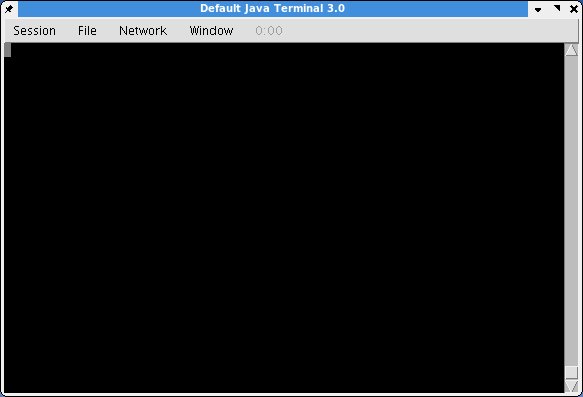 |
The session menu allows you to open a different session, edit a session's configuration, copy a session's configuration into a new session or delete a session.
You can also clear the terminal, reset the window or close the session window.
Windows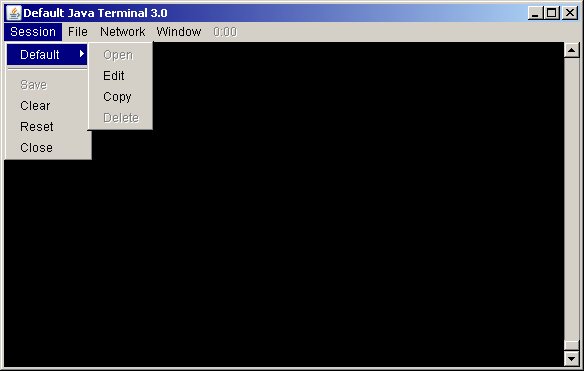 |
GNU Linux |
Using the edit option for a given session under the session menu you can edit the session's configuration.
The default session configuration does not allow you to change the session name "Default".
Windows 2000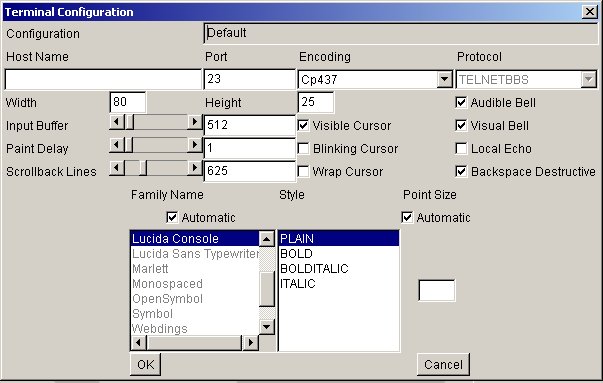 |
GNU Linux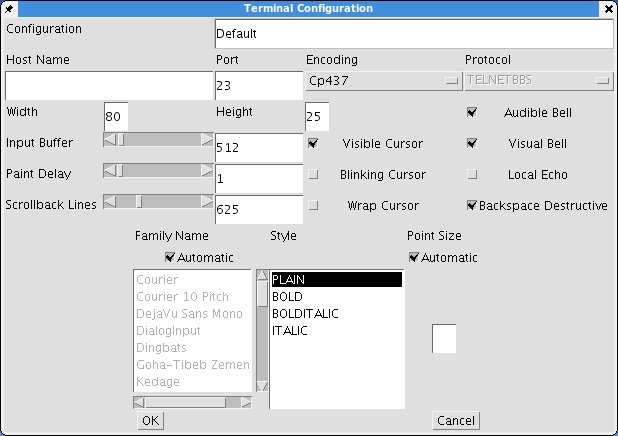 |
Using the copy option for a given session under the session menu you can copy the session's configuration.
Here we have copied the default session and are encouraged to change the session's name.
Windows |
GNU Linux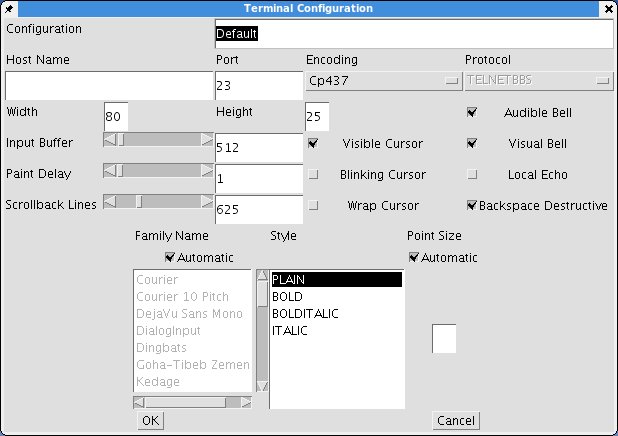 |
The file menu allows you to open a file for input processing, start a log file of raw terminal input, stop the log file or exit Java Terminal.
Windows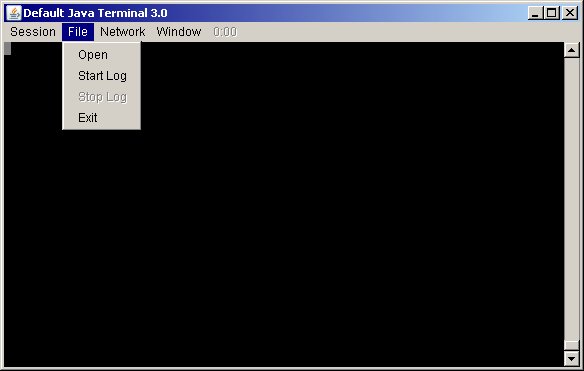 |
GNU Linux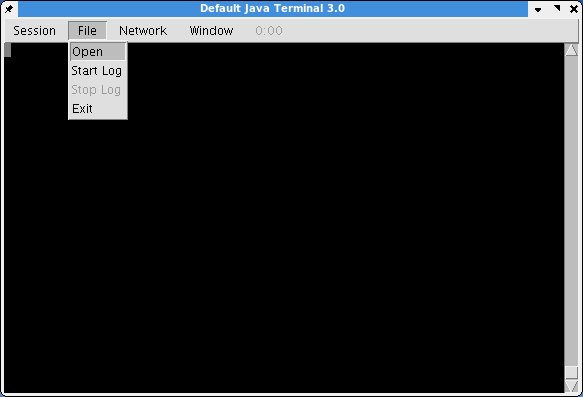 |
The network menu allows you to connect or disconnect from the session host.
After you connect to a host the timer will begin to count.
Windows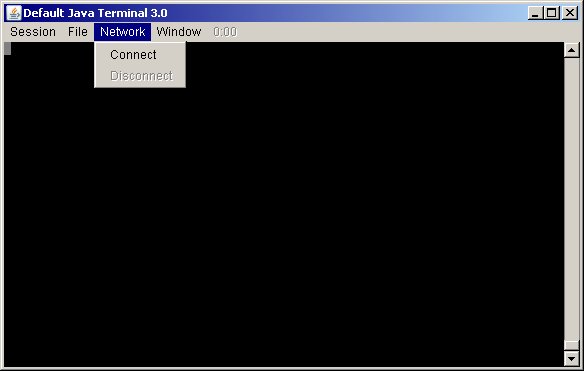 |
GNU Linux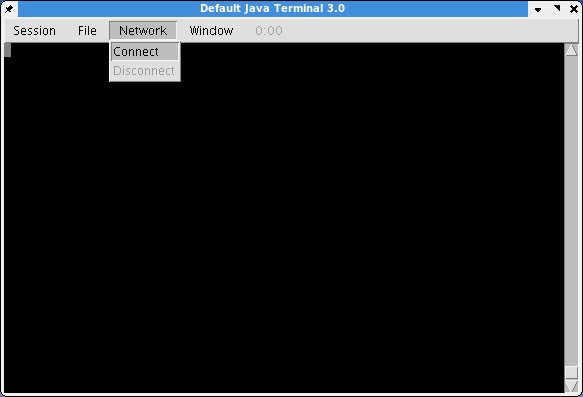 |
The window menu allows you to open a terminal session in a new window.
Windows |
GNU Linux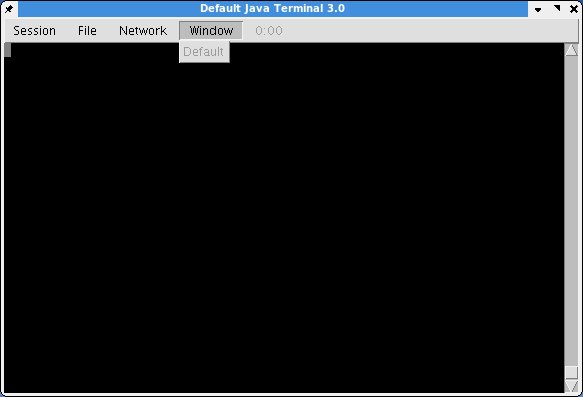 |
Configuration Options
The session configuration dialog
contains the following options.
| Host Name | Address name or dotted IP |
| Port | Port number |
| Encoding | Character encoding (Cp437 or ASCII is recommended) |
| Protocol | This option is disabled in version 3.0 |
| Width |
Terminal screen width |
| Height |
Terminal screen height |
| Input Buffer |
Bytes read before protocol interpretation begins (larger = faster, smaller = smoother) |
| Paint Delay | Delay before interpreted characters are painted (smaller = smoother, larger = faster) |
| Scrollback Lines | Number of lines in the scrollback buffer |
| Visible Cursor | Block cursor is visible |
| Blinking Cursor | Block cursor blinks |
| Wrap Cursor | Wrap cursor after last column |
| Audible Bell |
Bell notification plays a sound |
| Visual Bell |
Bell notification flashes scroll
lock |
| Local Echo | Repeat characters which you type |
| Backspace Destructive | Clear the character cell to the left of the cursor on backspace |
| Family Name | Font family name (Monospaced default, Lucida recommended) |
| Style | Font style (PLAIN default) |
| Point Size | Font size (depends on font family, 11 default, 17-21 is recommended) |
Keyboard
Most key sequences are sent "as-is",
including control characters (such
as Control-A).
However the following keys have special interpretations.
Mouse
The first left click will select the first character
and place it immediately in the clipboard. A subsequent left
click while holding down the SHIFT key will add that character as well
as all characters between the
first and last into the clipboard. Another way of doing this is
by left clicking on a character and holding down the mouse button while
you drag the selection highlighter.
Right clicking the mouse will paste any character text clipboard content into the output buffer as though it was typed. This copies what is on the system clipboard so copying from another program will work as long as only text is found in the clipboard.
Also the mouse wheel will scroll the screen view by an amount predefined by the Java runtime environment.
However the following keys have special interpretations.
| Page Up |
Moves the scrollback view up one
page. |
| Page Down |
Moves the scrollback view down
one page. |
| Arrow Up |
Character Discipline:
Sends a cursor up ANSI escape sequence to the host. Line Discipline: Scrolls to the preceding line of input. |
| Arrow Down |
Character Discipline:
Sends a cursor down ANSI escape sequence to the host. Line Discipline: Scrolls to the proceding line of input. |
| Arrow Right |
Character Discipline:
Sends a cursor right ANSI escape sequence to the host. Line Discipline: Moves the cursor to the right if there are characters proceding the cursor position. |
| Arrow Left |
Character Discipline:
Sends a cursor left ANSI escape sequence to the host. Line Discipline: Moves the cursor to the left if there are characters preceding the cursor position. |
Mouse
The first left click will select the first character
and place it immediately in the clipboard. A subsequent left
click while holding down the SHIFT key will add that character as well
as all characters between the
first and last into the clipboard. Another way of doing this is
by left clicking on a character and holding down the mouse button while
you drag the selection highlighter.Right clicking the mouse will paste any character text clipboard content into the output buffer as though it was typed. This copies what is on the system clipboard so copying from another program will work as long as only text is found in the clipboard.
Also the mouse wheel will scroll the screen view by an amount predefined by the Java runtime environment.
Java Terminal© Aaron Sami Abassi
SourceFORGE® Open Source Technology Group
Sun, Sun Microsystems, Java, J2SE, JDK are trademarks or registered trademarks of Sun Microsystems, Inc. in the United States and other countries.
Windows is a registered trademark of Microsoft Corporation in the United States and other countries